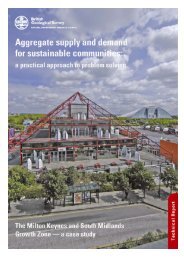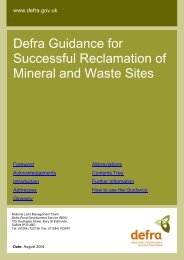creating environmental improvements through biodiversity
creating environmental improvements through biodiversity
creating environmental improvements through biodiversity
Create successful ePaper yourself
Turn your PDF publications into a flip-book with our unique Google optimized e-Paper software.
4 GAPS IN KNOWLEDGE /<br />
DIRECTIONS FOR FUTURE RESEARCH<br />
One key general principle that was apparent in many of the ALSF studies<br />
reviewed was that longer-term funding for longer-term projects will generate<br />
even better results in many cases. For example, a questionnaire response<br />
stated, in reference to Parker et al (2004), that “The short time span of the<br />
project meant that it closed just as farmers were starting to become engaged<br />
in the project. A longer time-span of say 3 years would enable further benefits<br />
to be realised.”<br />
Sustainable Aggregates Creating Environmental Improvements <strong>through</strong> Biodiversity<br />
Impacts of restoring for <strong>biodiversity</strong> on flood management<br />
The relationship between wetland creation on former mineral sites and flood management has not been well<br />
explored. Initial investigation into this issue suggests that the relationship is complex, and will vary depending<br />
on numerous factors (Clayton et al., 2004), but further research would enable a greater understanding of<br />
where and how the two outcomes can be aligned.<br />
Targeting habitat creation on future sites<br />
Different habitats will be appropriate and prioritised in different locations, and the most successful and<br />
beneficial restorations take account of their surroundings in this way. Understanding what habitats are<br />
appropriate in what locations at the earliest possible stages is key to strategic spatial planning of long-term<br />
landscapes, encourages discussion of potential blocks and facilitates best-practice site design. A tool to<br />
identify the habitats appropriate on potential future sites, depending on their location, would therefore be<br />
extremely advantageous. Historical and palaeo-<strong>environmental</strong> information can also be useful in this context.<br />
A fund to enable Mineral Planning Authorities (MPAs) to investigate which areas within their authorities<br />
should be priorities for <strong>creating</strong> which habitats on mineral sites, would be very useful. Targeting habitat enduses<br />
in this way would help rebuild fragmented landscapes of semi-natural habitats, deliver local BAP targets<br />
in a spatially appropriate way, ensure habitats were suitable for the locality and encourage cooperation. Few<br />
MPAs have the resources to collate the necessary data for this.<br />
Minimising risk of bird strike<br />
Better, more evidence-based guidance is needed by safeguarding authorities, developers, planners, restoration<br />
and land managers when considering the likely consequences of land use decisions within aerodrome<br />
safeguarding zones.<br />
More work is needed to understand the relationship between bird movements and land use (in particular<br />
new developments, such as minerals restorations), as a means of gauging the risk of bird-aircraft strikes<br />
occurring near aerodromes. Such work can inform minerals restoration design, helping meet both<br />
31

















